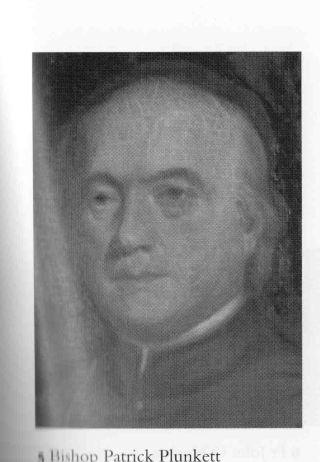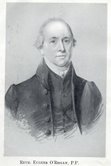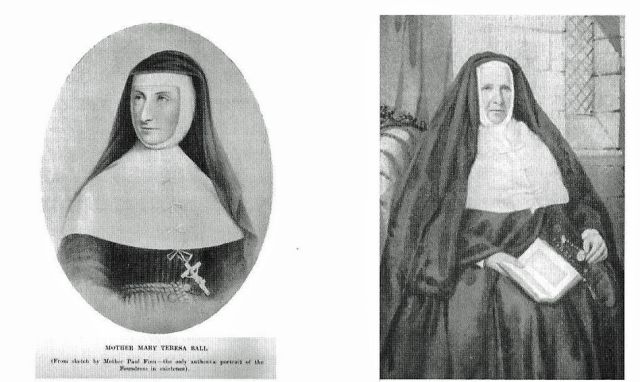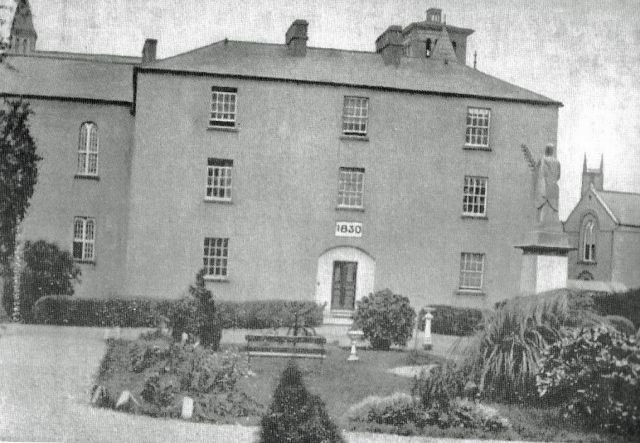A Loreto Ray of Hope
See also: Loreto Sisters
A Loreto Ray of Hope
by Máire O’ Donoghue
___________________
It was the 20th July 1833, a blistering hot summer‟s day in Navan. The well-to-do, living in spacious houses by the River Boyne enjoyed its cool refreshing waters as many ambled leisurely along its banks. But the dry, dusty streets of the town were not so inviting. Groups of poor children played desultorily up and down, while in a post Union Ireland their parents tried to eek a living out of practically nothing. An air of hopelessness prevailed.
Suddenly, a familiar but welcome sound was heard on Church Hill. A carriage drawn by four horses was seen fast approaching along the old coach road from Dublin. A carriage could mean a penny or two, so let‟s skip to it lads! It could also mean a skelp or two but it was worth taking the chance. The little urchins ran alongside the carriage as it slowly came to a halt at the entrance to a "slated house‟ near the church. A kindly gentleman and four equally kind ladies descended and smiled at the half starved children. Such tenderness struck them dumb. They watched in awe as Dr. Murray, Archbishop of Dublin and four Sisters of the Institute of the Blessed Virgin, later known as Loreto, were greeted by the Parish Priest, Rev. Mr. O‟ Reilly and his two curates Rev. Mr. MacElroy and Rev. Mr. Ennis.[1] No grand liturgical welcome for them, no church bells ringing. After all it was not long after the Catholic persecution in penal times and Catholics were treading tentatively in unsure waters!
The priests helped to unload the various parcels that were needed to start up a new foundation. Mother Paul Finn and Mother Francis Murphy, herself a Navan woman, carried between them on their knees, a large clock and refused to part with it even after the eight hour journey from Dublin until a suitable corner was found to deposit "this unerring keeper of the hours of religious observance." [2] The group of Sisters was led by Mother Teresa Ball, who ten years previously under the direction of Archbishop Murray had founded the Institute of the Blessed Virgin Mary. She was coming to Navan that day to open her first filiation in Ireland.
Saying goodbye to the children and promising them their first ray of hope the new arrivals with their clerical escorts made their way to the 'slated house', a house that was barely habitable. The new St. Anne's had "no ceiling in the upper parts and only a clay floor in the lower ones. The house was all quite damp, the walls wet, no grate in any room or chimney pieces in many. No gutters, the house not even dashed on the outside, no method of opening the greater number of the windows, the garden enclosed but on three sides and consisting of a gravel pit and a few large trees. The surface of the soil had been carried away. There stood in the midst of the garden, the ruins of old cabins." [3]
There was no electricity in those days, and oil lamps for that night at least were impracticable. It is recorded in the Convent Annals that the house did not possess as much as a candlestick. Instead, the Sisters were obliged to use wide-necked bottles in which to place their candles. Unperturbed they took in their situation with great good humour placing their trust in Our Lady and her Divine Son and quickly set about making the best of things and looking forward to the challenges which lay ahead.
You may ask how come it was the Loreto Sisters who first came to Navan? Who invited them and why? Let us go back to 1826 when the popular, but aged Dr Plunkett was Bishop of the Diocese of Meath. He lived in Navan. The Loreto Centenary Memoir tells the story that one evening a lady whose name is not recorded visited his Lordship and offered him £500 to help provide a school for the little street urchins of the town. Another lady anxious "to emulate the zeal of her friend" offered the Bishop another £500 to set up such a school. [4]
The Annals of the Convent, however, tell how the Convent was built "with the subscription of many pious persons, on ground purchased by Mrs Carroll of Trim for £500. Mrs Hand also left £513 11s 6d. The expenses were £1,480 11s 3d." [5] Now there was a Catholic school already in existence in the town but in name only because it repudiated clerical control. This was probably Miss Bird's establishment. The reason for this repudiation was because an anti-clerical mood had gripped the country due mainly to the Veto question, agrarian outrages and the long drawn out agitation for Catholic Emancipation. Dr. Plunkett nearly 90 died in 1827, a year after receiving the generous gifts. His successor Dr. Logan moved his residence to Kells.


Fig 1 Bishop Patrick Plunkett (left) and (right) Fig. 2 Rev. Eugene O'Reilly
Fr. Eugene O‟ Reilly, a man of vision, was Parish Priest of Navan. His first priority was for the education of the poor. He tried to work amicably with the existing school but the teacher there failed to cooperate with his ideas. This upset him greatly because so many poor children in the town were without education. He was also worried about the lack of higher education for girls. But being also a man of action he soon had a solution. He remembered the original gift of £1000. With what was left of it he began fitting up the "slated house" adjacent to the church. After three years he was able to invite the Loreto Sisters to Navan having first sought permission from the Archbishop of Dublin, Dr. Murray. [6]
Soon after their arrival Fr O‟ Reilly applied to the National Board for help stating "£500 has been given by an individual. £200 is required for the new school room(s) which are exclusively for the poor females of the town and neighbourhood and will be conducted by a Society of Ladies who will require no salary for their trouble."
"It is almost impossible for us to realise," says the Irish Catholic Magazine, "what a blessing those Sisters were. Soon over 300 children were attending their school daily. More than 150 of them got a warm breakfast in the Convent every morning. A high school, day and boarding, was established for the higher education of girls. That was not all. For a few hours after Mass every Sunday the Church was filled with women, young unmarried women, hundreds of them sitting in classes learning their prayers, being prepared for the Sacraments, all vying with one another in their love and reverence for the Sisters and now enjoying a peace and happiness which for them was a foretaste of Heaven." [7]

Fig 3 Mother Teresa Ball and (right) Fig. 4 Mother Mary Paul Finn
Who were these Sisters who arrived on that hot July day in 1833? What strengths and talents did they bring to a challenging mission?
The leader of this little group as I said earlier was Mother Teresa Ball. She was a devout follower of Mary Ward, a great lady who was centuries ahead of her time. In 1621 on Christmas Eve Mary visited the Holy House of Loreto in Italy because, according to authenticated testimony, the House of Nazareth was miraculously transported to Loreto in 1294. [8] There she found spiritual encouragement to continue to fight for the right to establish religious orders for women. In 1632 she founded the Institute of the Blessed Virgin back in those heretical days of James I. She had endured rejection, persecution and imprisonment in her campaign "to establish an army of uncloistered religious women to act under local supervision directed by a Mother General." [9]
Exactly two hundred years later following the example of Mary Ward, Mother Teresa Ball opened the doors of Rathfarnam Abbey and named it 'Loreto' which name now distinguishes every House of the Institute throughout Ireland. Mother Teresa stayed only a short while in Navan, long enough to see her Sisters settled. She left the running of the Convent in the capable hands of Mother Paul Finn, a banker's daughter. A convert to Catholicism, she repudiated balls and receptions to enter the religious state against the wishes of her family and friends. In 1836 she was appointed by Most Rev. Dr. Cantwell as Superior of the Navan community 'for life'. This burden she carried for thirty years. She had an affectionate heart, a zeal for souls and a devotion to the interests of Loreto.
It was she who built a new wing to house the free-school of St. Anne's which later was converted into the reception room in the Convent. Under her direction nuns' cells, a boarding school, and day-school quickly followed. The Annals record how this was the first Catholic day-school kept by nuns in Ireland. [10]
The Convent chapel which still exists today was also her idea. She herself joyfully writes that the first Mass was said in her New Chapel in 1841.
Mother Paul was ably assisted by Mother Francis Murphy, a native of Navan. Her vocation was quite dramatic. She was thirty five when she entered religious life in Rathfarnam and forty when she came to St. Anne's. Her presence in Navan must have caused quite a stir because the whole country knew her tragic story. She had been many times betrothed and each time her prospective husband died suddenly before the wedding. Her last fiancé fell from the top of a stagecoach as he was approaching her house. He died before her very eyes. Though very shocked she turned to God for guidance. "Lord what wouldst Thou have me to do?" The answer came and is recorded in her own words, "Choose a spouse that cannot be taken from you." [11]

Fig 5 Mother Francis Murphy
After coming to Navan in 1833 she was appointed Superior but resigned after a very short time not feeling equal to the job. Mother Francis lived on in Navan for forty years as Assistant Superior. According to the Convent Annals "She exceedingly advanced the interests of the house by her instructions in the schools especially in embroidery in which she excelled and was indefatigable. She embroidered sets and altar vestments, inspiring her pupils with great zeal and taste for these holy works. She opened a school for the poor on Sundays which has always been attended by crowds. Under her special auspices, also the charity by which for years numbers of poor children have been provided with breakfast daily has subsisted and progressed almost miraculously, the subscriptions for this charity having continued steadily paid for many years now." [12] Her charity during the famine years fed 150 poor children daily. When Mother Paul Finn left for England in 1863 she was again appointed Superior of St. Anne's, an office she held until 1869 when she again resigned for she was growing old. She died in 1872 leaving behind a "reputation for Christian benevolence to the neighbour and austerity in all that concerned herself." [ 13]

Fig 6 St. Anne’s Loreto as it appeared at the time of its centenary in 1933.
The fourth Sister who came to Navan on that July day was lay Sister Veronica Fox. She had been a lay novice in an English convent and was known as Monica Fox. Her sister appeared at the convent one day wanting to renounce a wild life and enter the religious one. But the Mother Superior was forced to reject her because convent rules only allowed a certain number to be admitted and that number had been reached. However she did agree to allow Monica give up her place to her sister. Monica came to Ireland and with the help of a priest whom she accidentally met in a hotel in Dublin was accepted into Mother Teresa Ball's Convent in Rathfarnam. She only stayed in Navan a few weeks and then returned to Rathfarnam. In 1841 she volunteered to accompany the first mission to India. Unfortunately in 1845 she died having contracted malaria.
These four Sisters, who introduced Loreto to Navan left their mark on a town, struggling with poverty, and religious and political conflict. The ray of hope they brought radiated throughout the town and lifted the spirits of a downtrodden people. Of those who entered St. Anne's on that memorable July day only Mother Francis Murphy lay in that little green Convent cemetery until she was reinterred in St. Michael‟s in July 1989 when the Loreto Sisters closed the doors of St. Anne‟s for the last time.
[1] Margaret Gibbons, Loreto Navan, 100 Years of Catholic Progress 1833-1933 (Navan 1933) p.1
[2] Ibid. p2
[3] Ibid. p4
[4] Ibid. p.6
[5] Loreto Annals St. Stephen's Green as quoted in History of the Diocese of Meath vol.1 Anthony Cogan p. 249
[6] Loreto Navan, p.7
[7] Ibid. p.7
[8] Ibid. p.9
[9] Ibid. p.11
[10] Ibid. p.21
[11] Ibid . p.22
[12] Ibid. p. 22
[13] Ibid.
Bibliography
Rev. John Brady, A Short History of the Parishes in the Diocese of Meath (Navan, 1937)
Dean Anthony Cogan, The Diocese of Meath Ancient and Modern vol 1 (Dublin, 1967)
Margaret Gibbons, Loreto Navan - One Hundred Years of Catholic Progress (1833-1933 (Navan, 1937)
The Loreto Annals
Irish Catholic Magazine